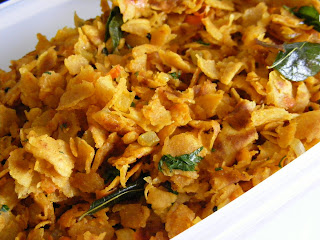 This is my entry for this month's CLICK event , the theme is Au Naturel.
This is my entry for this month's CLICK event , the theme is Au Naturel.
 This is my entry for this month's CLICK event , the theme is Au Naturel.
This is my entry for this month's CLICK event , the theme is Au Naturel.

Another version of the same Thalipeeth is made in a small cast iron butti/kadai. It is smeared with oil and the dough is spread in it to take the shape of the kadai. This kadai is then kept on slow flame, covered and cooked, turning the Thalipeeth to cook the other side as well. There is no change in the dough but this tastes so divine that even during my 'Non Thalipeeth' days I would easily devour 2-3 of them and then ask for more, to be reminded by Mom that it will then surely give me a stomachache :)

After the stupendous success of Dosa Mela, Srivalli of Cooking for all seasons has announced her Roti Mela just as I am drafting this. So I am sending it to this event right away!



This might have been devised to utilise the leftover chapati/Poli but we like it so much that I actually plan to make it and make fresh chapatis for the purpose. But it tastes best with the left over ones since the chapatis become a little crunchy. While the fresh ones are a little softer, the dish is great nevertheless.
I don't know if its the flour we get here, the climate or simply the way I make them but the chapatis do not remain soft once they go cold. Its best to have them while they are really hot straight from the tawa. I have tried almost everything now, kneading the dough with warm water, using a little oil while doing so, storing the chapatis in a proper container, wrapping them in cloth/kitchen towel/Aluminium foil etc but nothing seems to work. Of course the quality differs with the brand of flour that I get. So maybe it is the flour and not me! I do make good chapatis whenever I am back at home in India....:)
But whenever I am making PCP, that's GM's way of calling Phodni chi Poli, I like it that the chapatis are not very soft :).
Serves 2
Ingredients
5-6 Chapatis
1/2 tsp Mustard seeds
1/2 tsp haldi (Turmeric powder)
7-8 Curry leaves
1-2 Green chillies
1 small Onion
1 Tomato
1/2 tsp Sugar
Fresh Coriander leaves
Salt
Method:
Tear the chapatis into very little pieces. This is the only time consuming part of the recipe.You can make big pieces and then coarsely grind it but I feel that the handmade pieces taste better.






 I like almost all Movies by the great Hrishikesh Mukherji. I say almost because films like 'Jhoot Bole Kauwa Kaate' are not just in his league. Such movies make me wonder what he was thinking while he was making them. But all the rest of them are pure Gems (the precious kind, not the Cadbury's ones!). Some of them I have seen so many times that I could recite the dialogues even in my sleep. Whenever there was one being shown on the TV it used to be 'Oh, its been so many days since I last saw this movie!' & then I would sit in front of the TV for the whole time watching it as if it was the first time. These movies had a repeat value to them & you never get bored even if you know whats going to happen when. Anadi, Chupke Chupke, Anand, Guddi, Mili, Namak Haram, Abhimaan, Golmaal, Khubsoorat are just a few of his now rare gems.
I like almost all Movies by the great Hrishikesh Mukherji. I say almost because films like 'Jhoot Bole Kauwa Kaate' are not just in his league. Such movies make me wonder what he was thinking while he was making them. But all the rest of them are pure Gems (the precious kind, not the Cadbury's ones!). Some of them I have seen so many times that I could recite the dialogues even in my sleep. Whenever there was one being shown on the TV it used to be 'Oh, its been so many days since I last saw this movie!' & then I would sit in front of the TV for the whole time watching it as if it was the first time. These movies had a repeat value to them & you never get bored even if you know whats going to happen when. Anadi, Chupke Chupke, Anand, Guddi, Mili, Namak Haram, Abhimaan, Golmaal, Khubsoorat are just a few of his now rare gems.



 You may have to adjust the sugar a bit if the strawberries are a little sour in taste. I had to add 2-3 spoons more of sugar. Add the chopped almonds and refrigerate. You can also use other nuts, I think Pistachio would be very nice but I had run out of them yesterday. Serve chilled.
You may have to adjust the sugar a bit if the strawberries are a little sour in taste. I had to add 2-3 spoons more of sugar. Add the chopped almonds and refrigerate. You can also use other nuts, I think Pistachio would be very nice but I had run out of them yesterday. Serve chilled.



